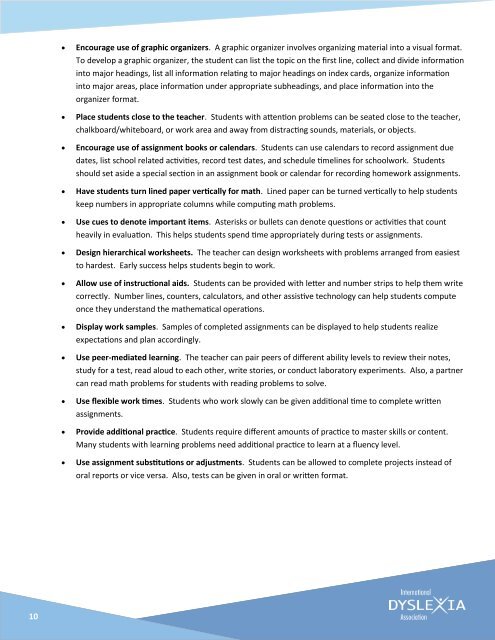Overcoming Dyslexia
Overcoming Dyslexia
Overcoming Dyslexia
You also want an ePaper? Increase the reach of your titles
YUMPU automatically turns print PDFs into web optimized ePapers that Google loves.
Encourage use of graphic organizers. A graphic organizer involves organizing material into a visual format.<br />
To develop a graphic organizer, the student can list the topic on the first line, collect and divide information<br />
into major headings, list all information relating to major headings on index cards, organize information<br />
into major areas, place information under appropriate subheadings, and place information into the<br />
organizer format.<br />
Place students close to the teacher. Students with attention problems can be seated close to the teacher,<br />
chalkboard/whiteboard, or work area and away from distracting sounds, materials, or objects.<br />
Encourage use of assignment books or calendars. Students can use calendars to record assignment due<br />
dates, list school related activities, record test dates, and schedule timelines for schoolwork. Students<br />
should set aside a special section in an assignment book or calendar for recording homework assignments.<br />
Have students turn lined paper vertically for math. Lined paper can be turned vertically to help students<br />
keep numbers in appropriate columns while computing math problems.<br />
Use cues to denote important items. Asterisks or bullets can denote questions or activities that count<br />
heavily in evaluation. This helps students spend time appropriately during tests or assignments.<br />
Design hierarchical worksheets. The teacher can design worksheets with problems arranged from easiest<br />
to hardest. Early success helps students begin to work.<br />
Allow use of instructional aids. Students can be provided with letter and number strips to help them write<br />
correctly. Number lines, counters, calculators, and other assistive technology can help students compute<br />
once they understand the mathematical operations.<br />
Display work samples. Samples of completed assignments can be displayed to help students realize<br />
expectations and plan accordingly.<br />
Use peer-mediated learning. The teacher can pair peers of different ability levels to review their notes,<br />
study for a test, read aloud to each other, write stories, or conduct laboratory experiments. Also, a partner<br />
can read math problems for students with reading problems to solve.<br />
Use flexible work times. Students who work slowly can be given additional time to complete written<br />
assignments.<br />
Provide additional practice. Students require different amounts of practice to master skills or content.<br />
Many students with learning problems need additional practice to learn at a fluency level.<br />
Use assignment substitutions or adjustments. Students can be allowed to complete projects instead of<br />
oral reports or vice versa. Also, tests can be given in oral or written format.<br />
10

















